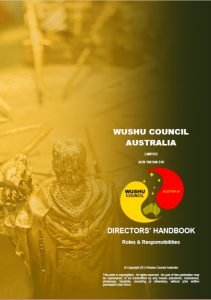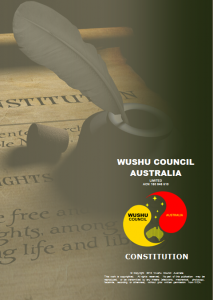
At Wushu Council Australia, we recommend all instructors and practitioners to get familiar with, and follow the WHS (Work and Health Safety) regulations to try and eliminate or minimise risks so far as is reasonably practicable.

At Wushu Council Australia, we recommend all instructors and practitioners to get familiar with, and follow the WHS (Work and Health Safety) regulations to try and eliminate or minimise risks so far as is reasonably practicable.

The Wushu Council Australia is managed by the Board of Directors (elected volunteer positions). The Board of Directors and the Council’s secretariat are responsible for the conduct and development of the organisation and its operations.
Members of the Council are the state organisations that look after Wushu, Tai Chi and Qigong practitioners residing in the state.
Each state organisation is based on individual membership and governed by the state committee of management.
Both the Council and its state members have partnership with relevant stakeholders, government bodies and commercial enterprises. Both the Council and its state organisations can delegate specific functions to the appointed committees with internal/external expertise.
This document is distributed among the Board Directors and State Committees of management to ensure they are familiar with the roles and responsibilities of the Board Directors.
The  Wushu Council Australia Limited is a Public Company Limited by Guarantee.
Wushu Council Australia Limited is a Public Company Limited by Guarantee.
The organisation carries its work through the state associations and is governed by the Board of Directors.
Objects of the organisation:
• To improve the physical, mental and social well-being of the citizens of Australia by the encouragement and promotion of all disciplines of the art of Wushu including but not limited to modern sport of Wushu, traditional Wushu, Taijiquan and Qigong and their benefits including its philosophical and cultural aspects.
• To provide the proper regulation of any activities associated with this.
• To work towards becoming the pre-eminent organisation taking full responsibility for the development of Wushu in Australia.
• To improve the standards of Wushu practice according to the recommendations of the Australian Sports Commission and the leading world Wushu regulatory body.
• To organise Wushu competitions at regional, state and national levels for competition-minded people.
• To raise the awareness of the philosophy and practice of Wushu among the citizens of Australia.
• To provide adequate representation of Australia in Wushu on the international level.
• To establish and maintain friendly and productive relations with other sporting bodies in Australia and overseas.
See the full text of the Constitution

The Wushu Council Australia’s mission is to unite Australian Wushu, Tai Chi and Qigong clubs, schools and individual practitioners into a strong community based on the best of traditions and contemporary developments, shared values and business interests aimed at promotion and advancement of Wushu in all its aspects.
We are to foster, develop and promote the art of Wushu, throughout Australia in an environment that encourages the practice of Wushu, in all its forms, by people of all ages to improve their fitness, health and well-being.
Fundamental to our success will be engaging and uniting Wushu, Tai Chi and Qigong practitioners and, thereby, creating a strong and harmonious community that can work together and assist in realising the benefits that Wushu can provide for our members and general public.
Above all, the Vision of the Wushu Council can only be achieved by effective leadership, and by displaying the core values of integrity and quality in everything we do.
See the Strategic Plan (Members only)

Rationale behind the Anti-Doping Policy:
The Wushu Council Australia condemns doping as fundamentally contrary to the spirit of sport.
Anti-doping programs, including documents such as this Anti-Doping Policy, seek to preserve what is intrinsically valuable about sport. The Essence of sport at all levels in Australia upholds the principles of Fairness, Respect, Responsibility and Safety.
The purposes of this Anti-Doping Policy and the anti-doping programs which it supports are:
• To protect Athletes’ fundamental right to participate in doping-free sport and thus promote health, fairness and equality for Athletes worldwide; and
• To ensure harmonised, coordinated and effective anti-doping programs at the international and national level with regard to detection, deterrence and prevention of doping.